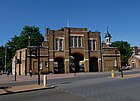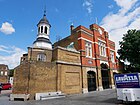
Thamesmead is an area of south-east London, England, straddling the border between the Royal Borough of Greenwich and the London Borough of Bexley. It is located 11 miles (18 km) east of Charing Cross, north-east of Woolwich and west of Erith. It mainly consists of social housing built from the mid-1960s onwards on former marshland on the south bank of the River Thames.

Woolwich is a district in southeast London, England, within the Royal Borough of Greenwich.

Woolwich Arsenal station is a National Rail and Docklands Light Railway (DLR) paired interchange station in the heart of Woolwich in the Royal Borough of Greenwich. It has two parts; its raised, south-western part of the station is on the semi-slow, commuter service, corollary of the North Kent Line and also in its Dartford Loop services section between London and Dartford, run by Southeastern. Regular services beyond Dartford are to the Medway Towns, which start/finish in the opposite direction at Luton via the City of London, West Hampstead and St Albans. Its other part is the terminus of its own branch of the DLR, run by Transport for London.

Woolwich Dockyard was an English naval dockyard along the river Thames at Woolwich in north-west Kent, where many ships were built from the early 16th century until the late 19th century. William Camden called it 'the Mother Dock of all England'. By virtue of the size and quantity of vessels built there, Woolwich Dockyard is described as having been 'among the most important shipyards of seventeenth-century Europe'. During the Age of Sail, the yard continued to be used for shipbuilding and repair work more or less consistently; in the 1830s a specialist factory within the dockyard oversaw the introduction of steam power for ships of the Royal Navy. At its largest extent it filled a 56-acre site north of Woolwich Church Street, between Warspite Road and New Ferry Approach; 19th-century naval vessels were fast outgrowing the yard, however, and it eventually closed in 1869. The former dockyard area is now partly residential, partly industrial, with remnants of its historic past having been restored.

The Royal Arsenal, Woolwich is an establishment on the south bank of the River Thames in Woolwich in south-east London, England, that was used for the manufacture of armaments and ammunition, proofing, and explosives research for the British armed forces. It was originally known as the Woolwich Warren, having begun on land previously used as a domestic warren in the grounds of a Tudor house, Tower Place. Much of the initial history of the site is linked with that of the Office of Ordnance, which purchased the Warren in the late 17th century in order to expand an earlier base at Gun Wharf in Woolwich Dockyard.
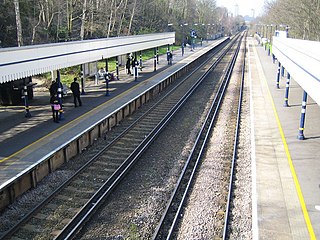
Plumstead railway station serves the suburb of Plumstead, in the Royal Borough of Greenwich, east of Woolwich Arsenal. It is 10 miles 1 chain (16.1 km) measured from London Charing Cross. It is served by Southeastern.

Woolwich Common is a common in Woolwich in southeast London, England. It is partly used as military land and partly as an urban park. Woolwich Common is a conservation area. It is part of the South East London Green Chain. It is also the name of a street on the east side of the common, as well as an electoral ward of the Royal Borough of Greenwich. The population of the ward at the 2011 Census was 17,499.
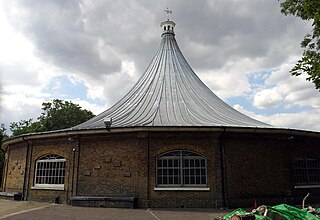
The Royal Artillery Museum, which was one of the world's oldest military museums, was first opened to the public in Woolwich in south-east London in 1820. It told the story of the development of artillery through the ages by way of a collection of artillery pieces from across the centuries. The museum had its roots in an earlier institution, the Royal Military Repository ; items which were once displayed in the Repository form the nucleus of the Royal Artillery Museum collection. Following the closure in 2016 of the museum, branded since 2001 as 'Firepower – The Royal Artillery Museum', its collection has been placed in storage pending the establishment of a new Royal Artillery Museum. The Royal Artillery Museum collections are designated as being of national and international significance by Arts Council England.

The Royal Arsenal Co-operative Society (RACS) was a large consumer co-operative based in south east London, England. The co-operative took its name from the Royal Arsenal munitions works in Woolwich and its motto was: "Each for all and all for each". In 1985 it merged into the national Co-operative Wholesale Society.

The Manor Ground located in Plumstead, south east London was a football stadium. This arena was the home of football club Royal Arsenal, which was later named Woolwich Arsenal, and as so came to be known as Arsenal F.C.
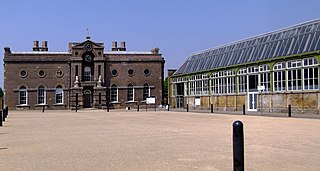
Greenwich Heritage Centre was a museum and local history resource centre in Woolwich, south-east London, England. It was established in 2003 by the London Borough of Greenwich and was run from 2014 by the Royal Greenwich Heritage Trust until the centre's closure in July 2018. The museum was based in a historic building in Artillery Square, in the Royal Arsenal complex, which was established in the 17th century as a repository and manufactory of heavy guns, ammunition and other military ware.
The Auto Stacker, also Autostacker, was an ambitious but ill-fated automated parking system in Woolwich, South East London in the early 1960s. The project was initiated by Woolwich Borough Council but failed to work and was demolished in 1965–66.

Winn's Common is a public open space in Plumstead in the Royal Borough of Greenwich, England.

Woolwich Town Hall is an early 20th-century town hall located in the historic Bathway Quarter in the centre of Woolwich, South East London. Until 1965 it was the seat of local government of the Metropolitan Borough of Woolwich, after which it became the headquarters of the Greenwich London Borough Council. It is a rare example of an Edwardian Baroque town hall in London and is a Grade II*-listed building.

The former Granada Cinema, also known as the Ebenezer Building or Cathedral of Christ Faith Tabernacle, in Woolwich, South East London, was built as a large and luxurious cinema in the 1930s. It had a seating capacity of nearly 2500 and is now being used as a church hall. The building with its extravagantly decorated interior is a Grade II* listed building.

Bathway Quarter is an area of historic interest in the centre of Woolwich, South East London. Most buildings in the Bathway Quarter are Grade II*, Grade II or locally listed, while the area as a whole is designated a conservation area by Greenwich Council. With the exception of the Old Town Hall, the listed buildings date from the late-19th or early-20th century. Several were designed by local architect Henry Hudson Church, their civic use reflected in their grand elevations formed of red brick with stone detailing.

St Peter's Church is a Roman Catholic church in Woolwich, South East London. It is situated between Woolwich New Road and Brookhill Road, the main entrance being on Woolwich New Road. The church was designed by Augustus Pugin in 1841–42 in the style of the Gothic Revival and is one of only three Pugin churches in London. Pugin's design remained unfinished as the projected tower and spire were never built. The parish of St Peter the Apostle serves the Catholic community of central Woolwich and surrounding areas, and is part of the Archdiocese of Southwark which is in the Province of Southwark.

Beresford Square is a pedestrianised town and market square in Woolwich in the Royal Borough of Greenwich in London, England. It was formed in the early 19th century and was named after the Anglo-Irish general William Beresford, Master-General of the Ordnance and Governor of the Royal Military Academy in Woolwich. With its lively street market and lined with shops, pubs and restaurants, Beresford Square has been the heart of Woolwich for over two centuries.

Powis Street is a partly pedestrianised shopping street in Woolwich in the Royal Borough of Greenwich, south east London, England. It was laid out in the late 18th century and was named after the Powis brothers, who developed most of the land in this part of the town. The street has been rebuilt several times but has retained some notable examples of late-Victorian and Art Deco architecture.

Old Woolwich or Woolwich Central Riverside is an area along the Thames in Woolwich, South East London. It is the oldest inhabited part of Woolwich, going back to an Anglo-Saxon riverside settlement. When the demographic centre of Woolwich shifted south in the 1800s, the area became a Victorian slum. Most of Old Woolwich was cleared in the 20th and early 21st centuries to make way for industrial, infrastructural and other large-scale developments. Although most of the earlier buildings have been demolished, the area has retained some interesting architecture, including the Georgian parish church, the Edwardian foot tunnel rotunda and two cinemas of the 1930s.





